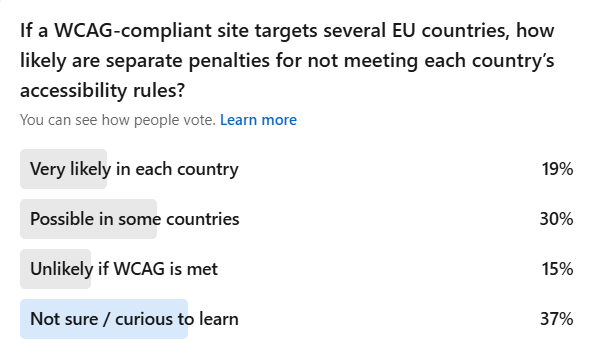Can a WCAG-compliant website still face multiple accessibility penalties in the EU? Let’s try to take a closer look at fragmented accessibility enforcement.
In theory, achieving WCAG 2.2 AA compliance should mean your website is accessible and aligned with international best practices.
In practice, the reality across the European Union is far more complex.
Here’s the catch: WCAG isn’t the law. Each EU member state enforces accessibility through its own national legislation, standards, and auditing procedures. These often reference WCAG, but they may also include additional requirements, such as France’s RGAA, Italy’s Legge Stanca, or Spain’s EN 301 549-based regulations.
This raises a pressing question for organisations running multilingual websites targeting multiple EU markets:
Could a single website, technically WCAG 2.2 AA compliant, still be penalised separately in each country where it fails to meet these local rules?
To explore this, I ran a LinkedIn poll asking accessibility professionals across the EU about their experience and observations. The responses reveal important insights into how fragmented enforcement can impact compliance strategies and why meeting WCAG alone is not always enough to stay penalty-free.

The poll results reveal a clear divide in perceptions among EU accessibility professionals. While 19% believe that multiple national penalties are very likely, and 30% see it as possible in some countries, 15% consider it unlikely if WCAG compliance is achieved. Notably, the largest share 37% expressed uncertainty and a desire to learn more. This spread of opinions highlights not only the complexity of Europe’s fragmented legal and enforcement landscape for digital accessibility but also the lack of clarity on how national standards interact with WCAG and the European Accessibility Act in practice.
This widespread uncertainty points to a deeper issue: Europe’s fragmented enforcement landscape for digital accessibility.
Why multiple penalties are still a risk for some websites
Despite a site being WCAG-compliant, several factors can expose companies to national-level penalties:
1. National standards layered on top of WCAG
Though WCAG is widely adopted, each country may add specific requirements.
For instance:
- France: The RGAA (based on WCAG/EN 301 549) must be followed. Non-compliance can result in fines up to €50,000 per non-compliant service, renewed every six months.
- Spain: Under Ley 11/2023, fines for serious infractions can reach up to €600,000, with additional penalties including bans from public sector contracts.
2. Automated testing isn’t legally definitive
Audit tools may flag issues (some false positives), but legal compliance ultimately depends on documentation, remediation efforts, testing with real users, and a defensible accessibility strategy. Tools like Axe or Lighthouse don’t test for all criteria (e.g., accessibility statements, keyboard traps, ARIA misuse). You still carry the burden of proof during audits or complaints.
3. No coordinated inforcement
Each EU country appoints its own enforcement body. While the European Accessibility Act (EAA) sets a harmonized baseline, enforcement, which includs fines, is still conducted at the national level. Some experts mentioned that cooperation under the EAA is growing, but fines and enforcement still happen nationally.
4. User complaints
Here is an important message: WCAG compliance doesn’t guarantee usability. If users with disabilities report barriers, especially if they interfere with essential services, you may be investigated regardless of audit results.
What can companies do
Here’s a practical roadmap to reduce risk:
| Risk Factor | Mitigation Strategy |
|---|---|
| National Variations | Audit for WCAG, RGAA (FR), EAA (ES) and EN 301 549 to cover all bases. |
| Tool Limitations | Supplement automated tests with human expert reviews and documentation. |
| User Complaints | Implement real-user testing and feedback channels. |
| Enforcement Sovereignty | Monitor national enforcement practices and maintain readiness for each jurisdiction. |
With national standards, additional legal requirements, and varied enforcement practices, companies operating multilingual websites face a patchwork of obligations that demand more than a one-size-fits-all approach. Proactive alignment with both WCAG and country-specific regulations, combined with ongoing user testing, remains the most reliable path to reducing legal risk and ensuring genuine accessibility for all users.

Leave a Reply